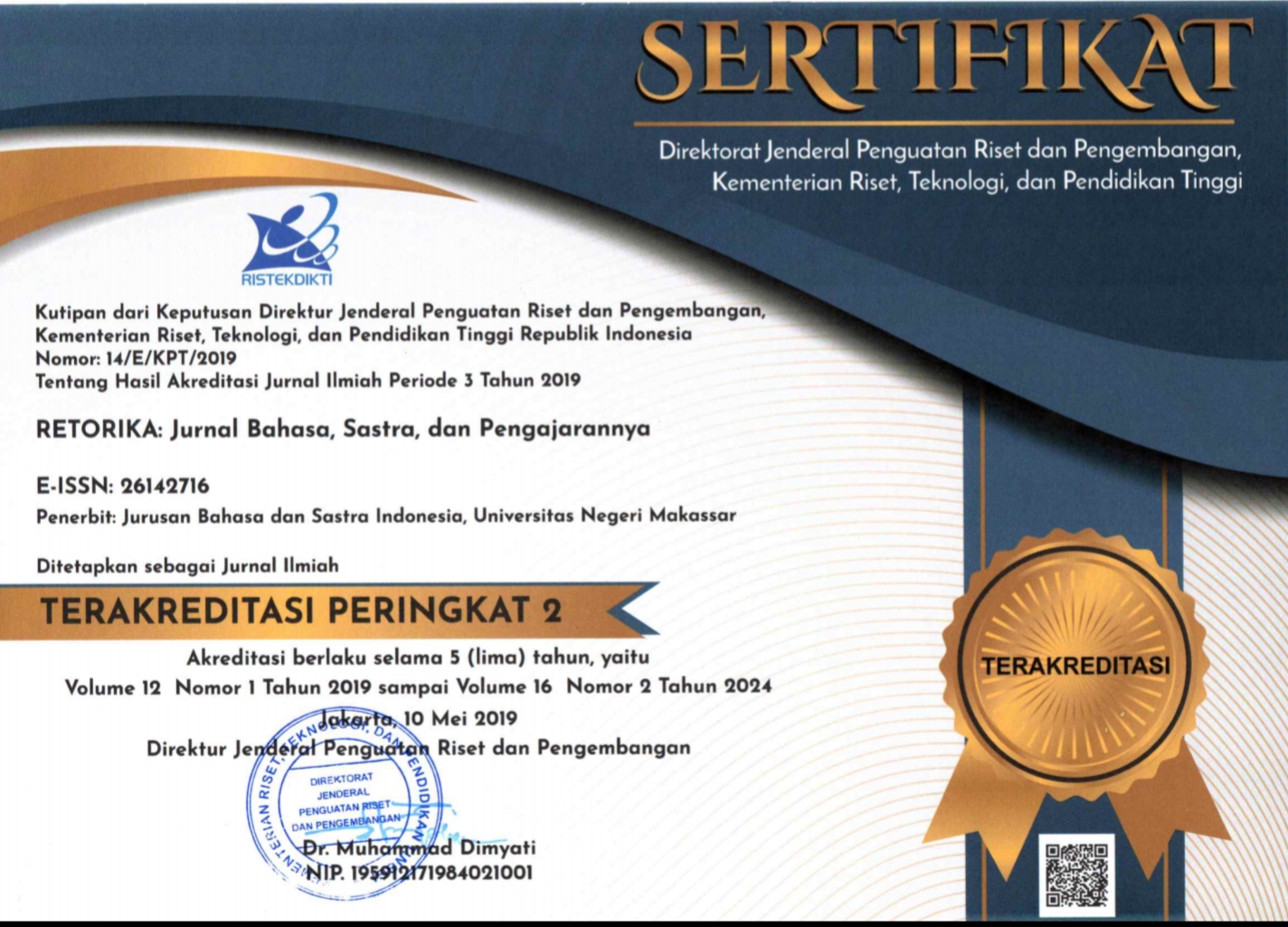VARIED ROLES OF METAPHORIC EXPRESSIONS IN PEPALI BABAD BANYUMASAN
(1) Department of Indonesian Language and Literature, Universitas Negeri Semarang
(2) Department of Indonesian Language and Literature, Universitas Negeri Semarang
(*) Corresponding Author
DOI: https://doi.org/10.26858/retorika.v16i2.13478
Abstract
This study aims to examine the various roles of metaphor in the oral literature of Pepali Babad Banyumasan. This study was qualitative and descriptive by its nature, meaning that all data are not in the form of numbers. It instead focused on the quality of verbal forms or utterances All data were retrieved from written excerpts of the prose. All data were retrieved from written excerpts of the prose. These data were further analyzed using a referential identity method and a reflective introspective method. The study found four functions of metaphor in Pepali Babad Banyumasan, such as to mention unique characteristics, to describe the place of origin, to substitute, and to concretize human experience. Oral literature of Banyumasan Javanese, especially the one discussed in the present study, is worth investigating. Pepaliis originated from Raden Baribin, Wira Utama, Yudanegara II, Yudanegara III, and others. Behind the fact that literary work is something inanimate, lies within Pepali is enigma and meaning to look at. The findings in this study are belief in magical and occult things as a way of life for taking attitudes for the ancient Javanese people, particularly the Banyumasan people that was used as a form of expression to concretize the representation of experiences in the past, then make it a message so that people are more vigilant and break bad luck in the present by reflecting on past experiences. In this study, it is clear that the ancient Javanese people believed in magical things as a form of human communication to get blessing in managing government. The ancient Javanese people of Banyumasan also believed that the name was also a sign to represent the image of the community group. In this case the name that appears to represent the aristocratic class of society (people who are destined to become leaders) by giving him a family name taken from the name of an animal, namely goose.
Keywords
Full Text:
PDFReferences
Aulia, Z. N., & Nur, T. (2020). Metafora Konseptual dalam Rubrik Unak-Anik Kahirupan Majalah Online Manglé: Analisis Semantik Kognitif. Lokabasa, 11(2), 226-236.
Cazeaux, Clive. (2007). Metaphor and Continental Philosophy: From Kant to Derrida. New York: Routledge.
Evans, V. (2007). A Glossary of Cognitive Linguistics. Edinburgh University Press.
Hofstadter, Douglas R.. (2001). The Analogical Mind: Perspectives from Cognitive Science. Gentner, Dedre.
Kamalu, Ikenna. (2013). Metafora dan Pendidikan: Menjelajahi Semiotik Sosial Sastra Anak Nigeria. International Journal on Studies in English Language and Literature (IJSELL), Vol. 1, No. 1, 30-40.
Knebel, J. (1901). Babad Banjoemas, Volgens een Banjoemaasch Handschrift Beschrevcn. TBG bagian XLIII: 397-443.
Kövecses, Zoltán. (2010). Metaphor: A Practical Introduction (Second Edition). Oxford/New York: Oxford University Press.
Lakoff, J. & Johnson, M.( 2003). Metaphors We Live by London. The University of Chicago Press.
Muhadjir, Noeng. (2001). Metodologi Penelitian Kualitatif. Yogyakarta: Rake Sarasin.
Orwell, George. (2012). Penggunaan Strategis Metafora oleh Elit Politik dan Media: Krisis Konstitusi Belgia 2007-2011. Jurnal Internasional Media & Politik Budaya, Vol. 8, Nomor 2, hlm. 229-249.
Prayogi, I., & Oktavianti, I. N. (2020). Mengenal Metafora dan Metafora Konseptual. Sasindo, 8(1): 45-70
Pristiwati, Rahayu. (2015). Fungsi Metafora dalam Wacana Kampanye Pemilihan Umum Presiden 2014. Seminar Internasional Nusantara Heritage ke-4, hlm 366-368; 23-25 Oktober 2015, ISBN 978-967-13724-0-1
Qiang, Huang. (2011). Sebuah Studi tentang Metafora "Merah" dalam Budaya Cina. American International Journal of Contemporary Research. Vol. 1 (3). 99-102.
Riddell, Patricia. (2016). Metaphor, Simile, Analogy and the Brain. Changing English, Vol. 23, No. 4, Hlm. 363—374.
Sudaryanto. (2015). Metode dan Aneka Teknik Analisis Bahasa. Yogyakarta: Sanata Dharma University Press.
Ullman, S. (2014). Pengantar Semantik..Yogyakarta: Pustaka Pelajar.
Vosniadou, Stella & Andrew, Ortony. (2003). Similarity and Analogical Reasoning. Cambridge: Cambridge University Press.
Wiradharma, G., & WS, A. T. (2016). Metafora dalam Lirik Lagu Dangdut: Kajian Semantik Kognitif. Arkhais-Jurnal Ilmu Bahasa dan Sastra Indonesia, 7(1), 5-14.
Williams, Ann E. (2013). Metafora, Media, dan Pasar. Jurnal Komunikasi Internasional, Vol 7, hal 1404-1417.
Zaimar, O. K. S. (2002). Majas dan Pembentukannya. Makara, Sosial Humaniora, Vol. 6, No. 2.
Article Metrics
Abstract view : 175 times | PDF view : 57 timesRefbacks
- There are currently no refbacks.
Copyright (c) 2023 Rahayu Pristiwati, Dyah Prabaningrum

This work is licensed under a Creative Commons Attribution-NonCommercial 4.0 International License.
Published by:
Department of Indonesian Language, Faculty of Languages and Literature, Universitas Negeri Makassar in cooperate with Asosiasi Dosen Bahasa dan Sastra Indonesia (ADOBSI) and Ikatan Program Studi Pendidikan Bahasa dan Sastra Indonesia (IKAPROBSI).
Address: Department of Indonesian Language Office, DG Building Second Floor, UNM Parangtambung, Daeng Tata Raya Street, Makassar, South Sulawesi, Indonesia
 Email: [email protected]
Email: [email protected]

RETORIKA: Jurnal Bahasa, Sastra,dan Pengajarannya is licensed under a Creative Commons Attribution-NonCommercial 4.0 International License.
















